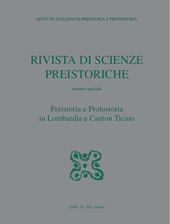Dal proxy ambientale alla testimonianza archeologica : un approccio multidisciplinare alla storia del paesaggio e dell'insediamento nella Leventina (Ticino) e nella zona subalpina
P. 49-61
While we are used to rely on archaeological features and finds to evidence human settlement and activity, there is a series of environmental proxies from soils, vegetation history, and floral or faunal remains that provide indirect and mostly off-site clues to human presence and impact on the natural environment. Landscape history can thus be built from both archaeological and environmental data; however, the two are not always in good accordance. Taking the site of Airolo-Madrano, the Leventina and Ticino Alpine valleys and their wider setting as an example, a multi-disciplinary research program investigated evidence for prehistoric settlement and the relationship between human activities and environmental transformations in the years 2004–12.
Archaeological information was gathered from archival sources, extensive and intensive survey activities, as well as archaeological excavations; vegetation history relied on pollen, macrofossil and charcoal signals in sediment cores, as well as on archaeobotanical and anthracological analysis of soil samples and settlement strata for subsistence activities. A large series of radiocarbon dates provided a reliable chronological framework, ranging from early postglacial to post-medieval periods, with a priority on the younger prehistoric periods. We focus on the pause and pulse signals obtained from the various environmental proxies and the chronological distribution of the archaeological evidence.
There is only partial overlap of the different data, and apparent contradictions between e.g., proxies for agricultural activity and a total lack of archaeological finds, such as in the Neolithic, or the obvious time shift between valley-bottom and subalpine sites in certain phases of the Bronze and Iron ages, leave ample room for the discussion of methodological and source-based problems. GIS-based models provide powerful visualization opportunities in these contexts. [Publisher's text]
-
Articles from the same issue (available individually)
-
Information
DOI: 10.32097/1163
ISSN: 2282-457X


